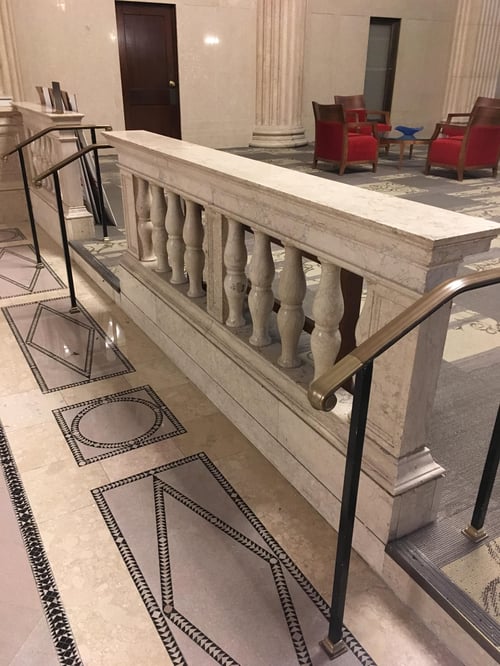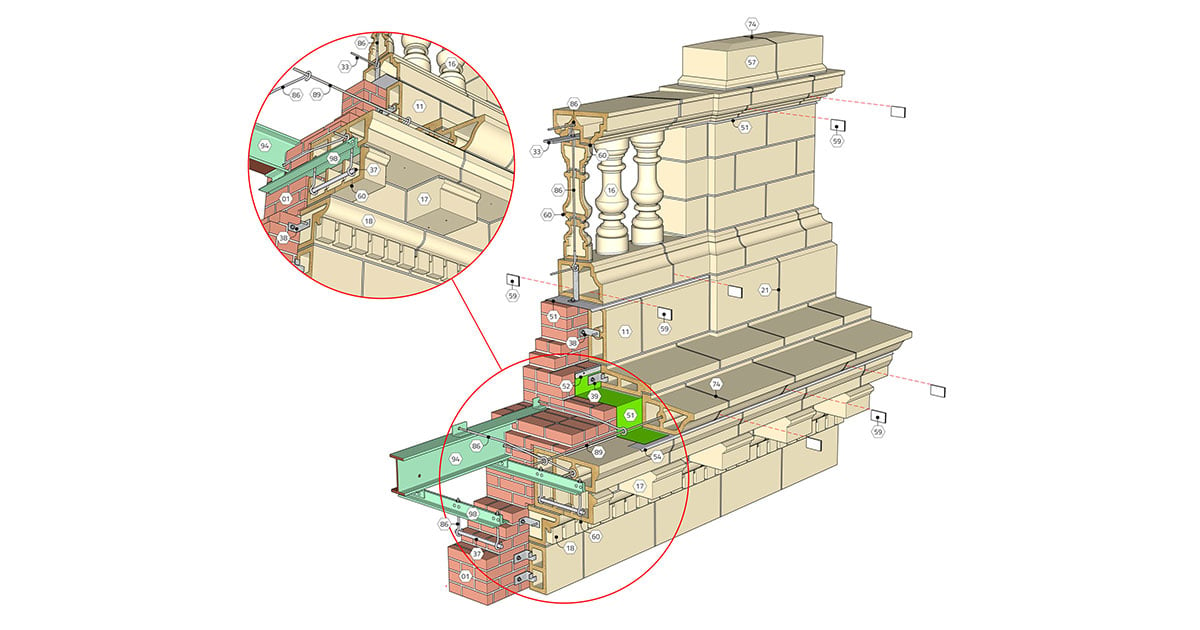The products used to clean and disinfect the interior of public and commercial buildings can have a big impact on the life cycle of interior masonry surfaces like tile and stone. However, equipped with the right information, a maintenance team can choose products that will not only kill harmful viruses and bacteria, but also safely clean masonry without disturbing or causing damage over time.
Understanding Cleaning Action
When choosing standard proprietary cleaning products, it’s helpful to know and understand the active ingredients that are responsible for breaking down germs and grime. Though not an exhaustive list, below are a few common active ingredients found in cleaning products today. These cleaning agents also disinfect.
Soap
 All soap, or surfactants, remove loosely adhered surface soiling and effectively bursts the cell membranes of viruses. Soap is generally categorized into two groups, ionic and non-ionic, meaning the former carries an electric charge and the latter does not. All soap, if not rinsed well, can leave a thin film on the surface which can attract soiling over time.
All soap, or surfactants, remove loosely adhered surface soiling and effectively bursts the cell membranes of viruses. Soap is generally categorized into two groups, ionic and non-ionic, meaning the former carries an electric charge and the latter does not. All soap, if not rinsed well, can leave a thin film on the surface which can attract soiling over time.
Alcohol
In a concentration of 70-95%, alcohol can kill viruses and bacteria by breaking down their cell walls through the denaturation of proteins. Alcohol, an organic solvent, dissolves oils and makes it easier to remove soil that may be trapped by oily buildup on a masonry surface.
Sodium hypochlorite
More commonly known as chlorine bleach, sodium hypochlorite is very effective in killing all micro-organisms including bacteria, fungus, and viruses. However, bleach is not a substantial agent for removing soiling on its own and can permanently lighten masonry. In addition, bleach is very strong and should always be diluted. Care should always be taken to never mix cleaners containing bleach with other cleaners.
Quaternary ammonium compounds
Quaternary ammonium compounds, also known as quats, are very effective in killing micro-organisms including viruses, bacteria, fungus, algae, and lichen through the process of denaturation of proteins. Quats are commonly used to remove biological growth from historic masonry, however they alone are not effective in removing soiling. Quats have also been linked to respiratory and skin irritation.
For more information, see the U.S. EPA’s list of active ingredients that disinfect.
Hydrogen Peroxide
Hydrogen peroxide has bactericidal, virucidal, sporicidal, and fungicidal properties by way of actually attacking fatty membranes of viruses and other essential cell components. However, like some other disinfecting agents, hydrogen peroxide in its typical concentration of 3% needs to remain in contact with a non-porous surface for 5-10 minutes or more to effectively kill germs and viruses. In addition, hydrogen peroxide is not an effective method in removing soiling from masonry surfaces and can damage calcium carbonate rich or polished stone because it is an acid.
Cleaning Masonry Surfaces
In all cleaning campaigns, for existing and new masonry, understanding the masonry material and type of soiling is critical in determining the proper method of cleaning. Siliceous stone as well as brick and terra cotta are robust enough to be cleaned with a dilute acidic cleaning solution. However, calcareous stone such as limestone, marble, and cast stone are acid-sensitive and can be easily etched or eroded by an acidic cleaning solution, therefore, a pH neutral or alkaline cleaning solution is more appropriate. Whichever methods are considered should be tested first (see the IMI Masonry Restoration Cleaning Flow Chart and IMI Masonry Restoration Cleaning Guide for more information).
Cleaning Historic Masonry Surfaces
Historic interior masonry surfaces as well as new polished masonry surfaces should be handled with greater sensitivity. Though tile, terrazzo, and natural stone are all durable and resilient materials, increased wear over many decades can render them more susceptible to damage through inappropriate cleaning. The cleaning and maintenance regimen of these materials should always begin with the least aggressive cleaning solution and approach possible. Other considerations when cleaning historic masonry interior surfaces is that some proprietary cleaning products include soluble salts which can be deposited on porous masonry surfaces over time through routine cleaning that does not include rinsing away the cleaning solution. Additionally, it’s important to use soft bristle brushes and make sure any proprietary cleaning wipes do not contain fine abrasives, as some do to help lift dirt but can ultimately scratch or dull polished surfaces.
Maintaining and extending the lifespan of beautiful interior stone, tile and terrazzo is not difficult if those charged with cleaning these surfaces have the right information. Through understanding the materials, the soiling present, and the appropriate cleaning products for each, a maintenance team can easily clean and disinfect without causing damage over time.
Download a PDF of this guide to save for your reference.







